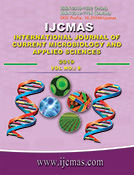


 National Academy of Agricultural Sciences (NAAS)
National Academy of Agricultural Sciences (NAAS)

|
PRINT ISSN : 2319-7692
Online ISSN : 2319-7706 Issues : 12 per year Publisher : Excellent Publishers Email : editorijcmas@gmail.com / submit@ijcmas.com Editor-in-chief: Dr.M.Prakash Index Copernicus ICV 2018: 95.39 NAAS RATING 2020: 5.38 |
Topographical and other constraints further limit the utilizable quantity of water which rapid growth in the demand for water due to rise in population, increased pace of urbanization and industrialization is posing serious challenges in providing food and water security. King Dalpatdev Kaktiya was a king from the Kakatiya dynasty who made reservoir in north-west part of Jagdalpur and named Dalpatsagar is now being affected badly by city expansion and draining sewage into the reservoir. Earlier the people settled at top of the toposequence which supported for run off flow but expansion of city on catchment areas created problem. For assessing effect of Dalpatsagar on water resource, the data on 121 dugwells and borewells were taken under consideration of depth pre (April-May) and post (October-November) monsoon observations during 2015-16 along with locations in Jagdalpur city. In which 121 dugwells, 60 as dirty water, 12 drying in pre monsoon period and 36 for drinking purpose were noticed under intensive observations during 2015-17. Maximum dugwells were recorded in Gandhinagar ward (17), followed by Dantewshari ward (15), Ambetkar ward (15) and Shyama Prasad Mukherjee ward (11) and Ravindrnath Tagore ward (9) in draining area of city watershed demarcated as recharge zone due to stagnation of water in two storage structures namely Dalpatsagar and Ganga Munda aligned in way of natural drainline. Water table of borewells allows explaining 4% variability in depth which was in between 100 to 150 feet bgl (below ground level) but linear trend highly variable around the line. Standard residuals versus depth of tube wells were also widely distributed in depth for pumping water, water table plotted against standard residuals was found between 80 to 100 feet bgl, on other hand, predicted water table on standard residuals ranged negatively and positively in between 80 to 100 feet bgl i.e. pumping water at common depth of the Jagdalpur city. In future, water availability will be in prime focus under dwindling rainfall if hydrological assessment is not done on management catchment and command areas. Turbidity, pH, conductivity, alkalinity, chloride, calcium, iron, biological oxygen demand, chemical oxygen demand were higher than allowable limit in August 2015 whereas nitrate, total hardness (CaCO3), Mg, fluoride, sulphate, TSS, residual Cl and dissolved oxygen were less than allowable level during April 2016.
 |
 |
 |
 |
 |